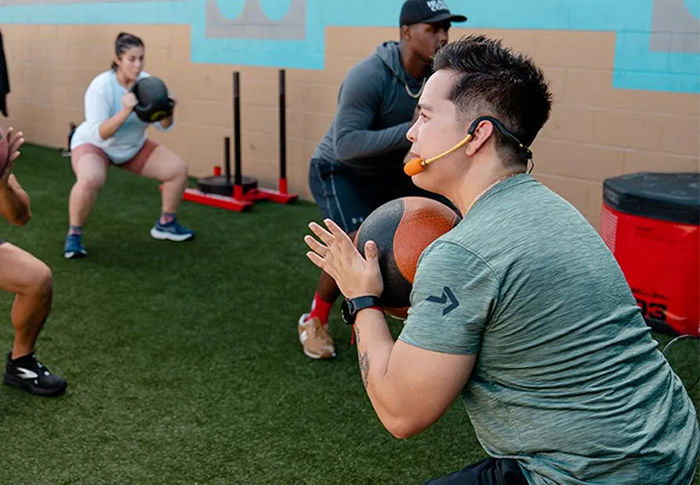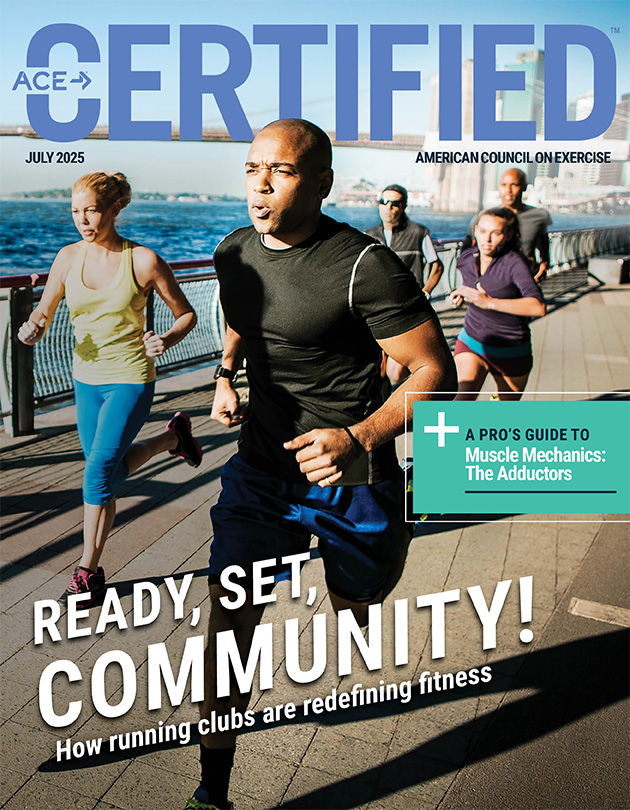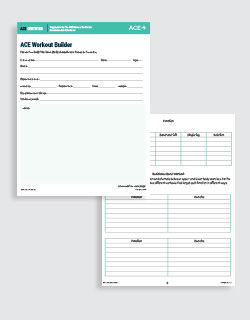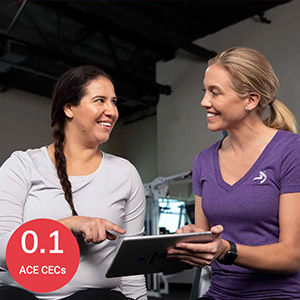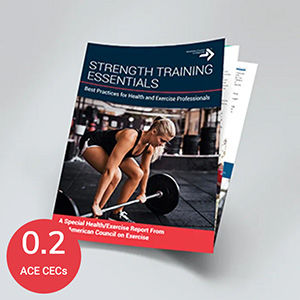The ACE Workout Builder for Resistance Band Workouts

Resistance bands don’t get the love they deserve.
They are cost-effective, versatile, portable and, most importantly, effective. Long relegated to articles about exercise options while staying in a hotel room or when building home gyms with limited space, bands deserve a more prominent place in conversations around resistance training. After all, they offer unique benefits compared to free weights and weight machines and may be a safer choice for older adults and newcomers to resistance training—while still challenging more experienced exercisers.
What makes resistance bands different is the dynamic resistance they provide during both concentric and eccentric movements. Consider the biceps curl. During the concentric (i.e., lifting) phase, the tension increases as the band stretches, meaning the biceps are working harder and harder as they move toward the end range of motion. Then, during the eccentric (i.e., lowering) phase, the muscles have to resist the recoil of the band as it shortens, further challenging them.
Imagine if you attached one end of a resistance band to an anchor, stretched it as far as it could go and then let go (don’t ever do this!). It would rapidly recoil in a dangerous and chaotic way. On the other hand, if you slowly walked back to the point of attachment, it would take effort to return the band to its normal resting length.
Another benefit of resistance bands that differentiates them from free weights is the ability to work the muscles in varying directions. For example, a traditional chest press exercise is done while laying on a bench and lifting the weights upward, against the force of gravity. Resistance bands allow you to perform a standing chest press where the band is anchored behind you, wrapped around your back or held by a partner, and this version of the exercise may be better for clients who are working on standing balance or exercising with heavier resistance that would require a spotter when using free weights.
Yet another tremendous benefit of using bands is that you can challenge your muscles at slightly different angles without having to adjust a bench or move to a new machine. The chest press exercise is again a great example. You might anchor the band at the side of a door frame and push straight out to perform the exercise. On subsequent sets, you can push the band slightly upward or downward to challenge the muscles of the chest in different ways and isolate different portions of the muscle group, just as you would with incline and decline presses.
A Primer on How to Use Resistance Bands
Resistance bands can be used to target all the major muscle groups. In many exercises, one end of the band (or side of the loop) is anchored to a stable object. This might be a doorframe, part of a weight machine or a tree branch if a client is exercising outdoors. You can also purchase wall- or door-mounted anchors.
In un-anchored band exercises, the exerciser either holds the band with both hands or stands on it to create a fixed point from which to push or pull. Think again of the biceps curl, where the exerciser is standing on the band to provide the “anchor” point. Another option is to loop the band around the feet during seated floor-based exercises.
The key is to adjust the resistance by either choosing a different band (thicker for more resistance, thinner for less) or moving in relation to the anchor point (farther away for more resistance, closer for less). It can take some trial and error to get things right, but making adjustments is simple.
Always be sure to adhere to the manufacturer’s guidelines when it comes to maintaining your resistance bands. Before each use, inspect the bands and handles (if applicable), looking for cuts, cracks, punctures or other damage. If a band is damaged in any way, do not attempt to use or repair it; a damaged band must be discarded for the sake of safety.
While following manufacturer guidelines is essential, the following are some general tips for safely using, storing and cleaning resistance bands:
- If your bands have handles, check the connection point before each use, as this can be a weak spot on the bands.
- Clear the workout area of any sharp objects that might damage the bands and be extra careful if you have sharp fingernails or jewelry.
- Never release a band while it’s under tension.
- Begin all exercises slowly and avoid jerking the band.
- Do not place the handles (if your bands have them) over the feet, as they can easily slip off.
- Never stretch a band beyond its capacity (typically 2.5 or three times its resting length, depending on the manufacturer).
- Do not use bands on uneven surfaces.
- Clean bands with a damp cloth after each use and store them out of direct sunlight, away from heat sources and out of extreme cold.
Bands also require the muscles to stabilize the body more so than weight machines, which guide the movement along a fixed path. This added challenge is often thought of as a benefit of free weights over machines, but the same holds true for resistance bands.
All of this is not meant to imply that resistance bands are a better option than free weights, weight machines or any of the other types of equipment available, but that they are a safe and effective option that more people should be considering when they design their workouts.
What the Evidence Reveals
In the introduction to a study entitled “Effects of training with elastic resistance versus conventional resistance on muscular strength,” the researchers cite several earlier studies when they write, “[The benefits of elastic resistance training] include improved functional capacity, increased strength and endurance with increased muscle activation, and improved body composition, potency, and quality of life.”
This study compared the results of exercise using elastic resistance (i.e., resistance bands) to the those from using weight machines and dumbbells, particularly in terms of muscular strength. Across diverse exercise programs with different populations, they found that, “Elastic resistance training is able to promote similar strength gains to conventional resistance training,” meaning that exercise professionals can use this practical, low-cost tool to elicit real results for their clients.
Here is a quick rundown of other important research on the effectiveness of training with resistance bands:
- Elastic resistance elicits improvements in both strength and performance across several types and durations of exercise programs.
- Exercising with resistance bands positively impacts the ability to perform activities of daily living (ADL), as well as hand muscle strength, balance, and lower-limb muscle strength in older adults living in long-term care facilities.
- Resistance bands can increase explosive strength. Researchers noted that while dumbbells are effective in training for muscular strength, bands make it easier to train for muscular power since they enable the user to lift heavy weights more quickly.
What all of this research collectively illustrates is that resistance bands can drive results regardless of your client’s abilities and goals, from beginners working on improving function to athletes seeking to enhance muscular power. The key lies in creative programming and optimizing results through appropriate modifications and progressions.
At the end of the day, resistance is resistance. While there are certainly differences among the various types of equipment in terms of how they challenge the body, what this research shows is that the benefits of resistance training are relatively consistent regardless of the type of equipment chosen.
A Sample Workout
While resistance-band workouts can be organized by function, lower-body/upper-body splits or even as a form of circuit training, the workout below was created using the Body Area/Muscle Group section of the ACE Workout Builder (see the link above for a downloadable PDF). After working with the client to fill in page 1 of that document, the next step is to create an exercise list that aligns with the client’s abilities and goals. Use the ACE Exercise Library to find exercises based on equipment availability and difficultly level. The following is a sample list of exercises.
Note that while some of these exercises are shown using a cable machine, they can be modified to be performed using resistance bands by anchoring the band at the position shown in the video clip.
|
Upper Body |
Torso |
Lower Body |
||||
|
Chest |
Back |
Shoulders |
Arms |
Torso |
Hips |
Legs |
The sample workout below can be performed two to three days per week. Share the following instructions with your client:
- Complete one set of each exercise in the order listed and be sure to transition between exercises with little to no rest.
- Perform each exercise for eight to 15 repetitions using a variety of resistance bands to allow for an intensity that allows you to perform each exercise for the desired number of repetitions.
- You can progress to two to four sets over time. If performing multiple sets of each exercise, complete the full workout before starting back at the top to complete another round. In other words, do not complete multiple sets of each exercise consecutively before moving to the next one; instead, complete the full workout, then start back at the beginning.
Sample Workout
|
Body Area/Muscle Group |
Exercise |
|
Chest |
|
|
Hips |
|
|
Back |
|
|
Legs |
|
|
Shoulder |
|
|
Torso |
|
|
Arms |
|
|
Torso |
|
|
Arms |
Final Thoughts
Resistance bands are a safe and effective addition to any client’s resistance-training program, whether they serve as the sole or primary type of equipment used, as an at-home option when a client can’t make it to the gym or as a way to continue exercising during prolonged breaks from their usual routine. Bands are often thought of as a tool for beginners or older adults, but they can be the centerpiece of a challenging muscular training regimen and should be part of every health and exercise professional’s toolbox.
Expand Your Knowledge
Exercise Programming: Applying the ACE Mover Method
At the core of the ACE IFT® Model is the ACE Mover Method, which is ACE’s behavior change philosophy put into actionable steps that help you practice empathy and trust, communication and collaboration. In this video training, you will dive deeper into the ACE IFT® Model through the lens of the ACE Mover Method, which includes the ACE ABC Approach. You’ll learn ways to effectively use the ACE Mover Method to transition clients between phases within each of the ACE IFT® components and throughout their fitness journey.
Muscular fitness helps with much more than increased strength—it also reduces the risk of injury, contributes to a healthy body weight and improves general health. Based on the research series “ACE Health and Wellness Reports,” this easy-to-understand course addresses the key factors involved in resistance training—from the physiological and psychological benefits of strength training to an overview of muscle structure and function. In addition, it provides a detailed look into the basic elements of safe resistance training and features an inclusive review of research-based training recommendations.
More Articles
- Certified™: July 2025
More Than a Workout: Creating Connection and Impact Through Running Clubs
Contributor
- Certified™: July 2025
ACE SUPPORTED RESEARCH: Do Youth Coaches Need Coaching? A Follow-up Study
- Certified™: July 2025
A Pro’s Guide to Muscle Mechanics: The Hip Adductors
Health and Fitness Expert


